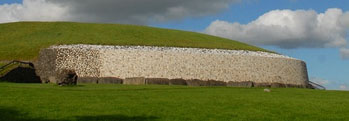Passage Tombs
Irish and Celtic myths and legends, Irish folklore, Irish fairy tales and More Irish Tales and Legends
Passage Tombs of Ireland
 Perhaps some of the most famous of all of Ireland's great Megalithic monuments are the passage tombs. Nothing fires the imagination like the beautiful spiral designs adorning their interiors, their careful alignment with astronomical wonders, and above all else their abiding mystery. For centuries people have come upon them and gazed in wonder, asking questions that we have only begun to answer today.
Perhaps some of the most famous of all of Ireland's great Megalithic monuments are the passage tombs. Nothing fires the imagination like the beautiful spiral designs adorning their interiors, their careful alignment with astronomical wonders, and above all else their abiding mystery. For centuries people have come upon them and gazed in wonder, asking questions that we have only begun to answer today.
Passage tombs are related to court tombs, and would have been constructed at around the same time, althugh probably not by the same tradition. As we learn more about them, they reveal surprise after surprise. Early philosophers and archaeologists thought they had arrived in Ireland from Europe towards the end of the Neolithic age, beginning in the east of the country and losing complexity as it progressed towards the west coast and the Atlantic ocean.
But in fact we now know that passage tombs originated on the west coast with tombs like the simpler work of Carrowmore in Sligo around 4000 BC, curving towards the east until they became the extraordinary and sophisticated monuments in the Boyne valley and Loughcrew almost a thousand years later! Whether they spread from Ireland to the rest of Europe and North Africa, and even further abroad, is not known yet.
Whether found singly or, more often, in groups with other monuments, it is not clear that they were used primarily as tombs, or as ceremonial or cultural centres. They usually feature a low passage leading into a central chamber, from which radiate several other chambers or passages, all beneath a great earthen or stone mound.
The Neolithic peoples seem to have been ancestor worshippers along with conventional deities and spirits, and the ancestor cult found its fullest expression in the great passage tombs.
Many of those buried in the tombs for the best part of a thousand years - much longer than other burial types of the time - seem to have been closely related, hinting perhaps at dynastic God-Kings. Family connections between people buried at Carrowmore, Carrowkeel, Millin Bay and Newgrange have been demonstrated, and the passage tomb people appear to be different from the occupants of other Neolithic monuments and the general Irish Neolithic people.
What's more, Irish passage tombs are very similar to other monuments in Brittany, Wales and Scotland, so it is not unlikely that they had connections to other dynasties across Europe, ruling the Neolithic for many centuries.
As well as human remains, many artifacts have been found in these ancient complexes, including pins fashioned from bone or red deer antler, pieces of quartz, flint or chert tools, stone or chalk balls, carved and polished stone pendants, and pottery called Carrowkeel ware, so called because it was first found in Carrowkeel. The pots, formed of reddish clay, are fashioned in a variety of sizes, but are always round.
Their alignments to the sun, moon and stars at particular times of year is famous, with the best-known perhaps being the alignment of Newgrange with the rays of the sun during the solstice. This gives us an insight into their beliefs and what they held to be of importance, both spiritually and physically. There is often structure beyond their design visible in the position of these mighty edifices among landscape features such as lakes, rivers and mountains.
Newgrange represents the largest and most complex passage tomb complex in the world, but it also represents one of the last to be built, the end of the tradition and most likely the end of the ruling God-Kings of ancient Europe.
Passage Tombs of Ireland
One of the most imposing legacies of the last of the mighty megalith-builders of the Neolithic and Bronze ages, the Dolmen of the Four Maols, considered by some to be a cist tomb rather than a dolmen or portal tomb. An enormous capstone sits above three other stones, while the entry stone lies not far off. It was once covered by a cairn of smaller ... [more]
Older than Stonehenge and the great pyramids of Giza stands Newgrange, the heart of legends and mysteries stretching back five thousand years. Situated along the river Boyne near to numerous other such places like Knowth and Dowth, that very same river where Fionn Mac Cumhaill was said to have first found and tasted the salmon of knowledge, and the ... [more]






